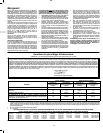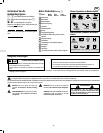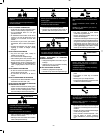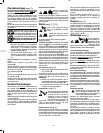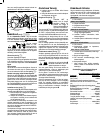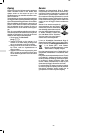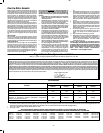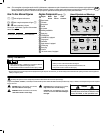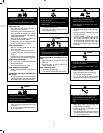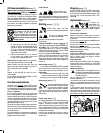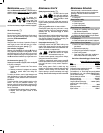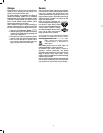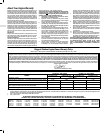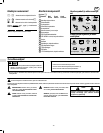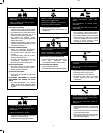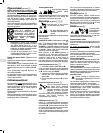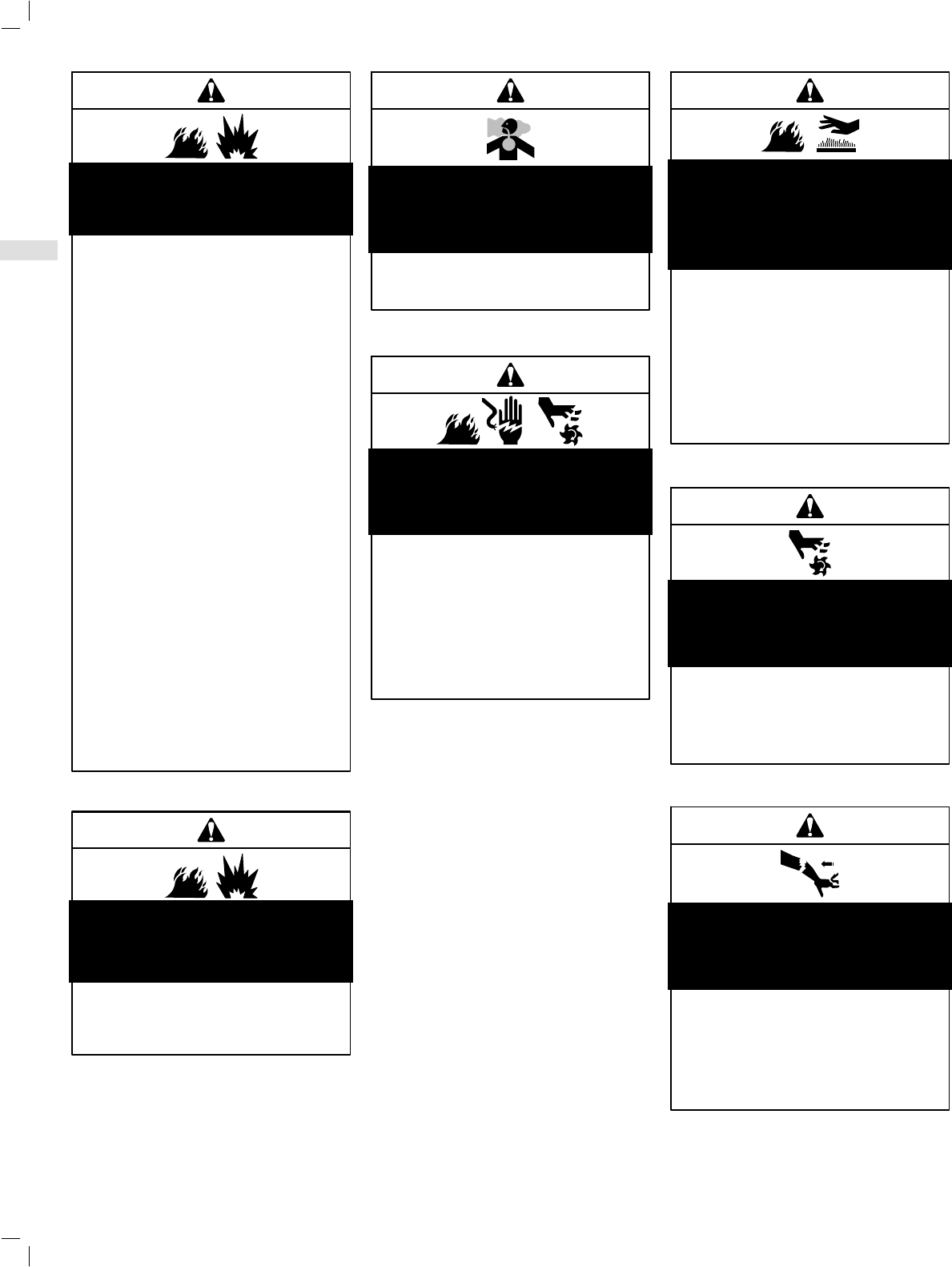
GB
2
WARNING
Gasoline and its vapors are extremely flammable
and explosive.
Fireor explosioncan cause severeburns ordeath.
WHEN ADDING FUEL
• Turn engine OFF and let engine cool at least 2
minutes before removing gas cap.
• Fill fuel tank outdoors or in well-ventilated area.
• Do not overfill fuel tank. Fill tank to approximately
1/2 inch below lowest portion offill opening to
allow for fuel expansion.
• Keepgasolineawayfromsparks,openflames,pilot
lights, heat, and other ignition sources.
• Check fuel lines, tank, cap, and fittings frequently
for cracks or leaks. Replace if necessary.
WHEN STARTING ENGINE
• Make sure spark plug, muffler, fuel cap and air
cleaner are in place.
• Do not crank engine with spark plug removed.
• If fuel spills, wait until it evaporates before starting
engine.
• If engine floods, set choke to OPEN/RUN position,
placethrottleinFASTandcrank untilenginestarts.
WHEN OPERATING EQUIPMENT
• Do not tip engine or equipment at angle which
causes gasoline to spill.
• Do not choke carburetor to stop engine.
WHEN TRANSPORTING EQUIPMENT
• TransportwithfueltankEMPTYorwithfuelshut-off
valve OFF.
WHEN STORING GASOLINE OR EQUIPMENT WITH
FUEL IN TANK
• Store awayfromfurnaces,stoves,waterheatersor
otherappliancesthathavepilotlightorotherignition
source because they can ignite gasoline vapors.
Starting engine creates sparking.
Sparking can ignite nearby flammable gases.
Explosion and fire could result.
• If there is natural or LP gas leakage in area, do not
start engine.
• Do not use pressurized starting fluids because
vapors are flammable.
WARNING
Unintentional sparking can result in fire or electric
shock.
Unintentional start-up can result in entanglement,
traumatic amputation, or laceration.
BEFORE PERFORMING ADJUSTMENTS OR RE-
PAIRS
• Disconnect spark plug wire and keep it away from
spark plug.
• Disconnect battery at negative terminal (only
engines with electric start).
WHEN TESTING FOR SPARK
• Use approved spark plug tester.
• Do not check for spark with spark plug removed.
WARNING
Engines give off carbon monoxide, an odorless,
colorless, poison gas.
Breathing carbon monoxide can cause nausea,
fainting or death.
• Start and run engine outdoors.
• Do not start or run engine in enclosed area, even if
doors or windows are open.
WARNING
Running engines produce heat. Engine parts,
especially muffler, become extremely hot.
Severe thermal burns can occur on contact.
Combustible debris, such as leaves, grass, brush,
etc. can catch fire.
• Allowmuffler,enginecylinderandfinstocoolbefore
touching.
• Remove accumulated combustibles from muffler
area and cylinder area.
• Install and maintain in working order a spark
arresterbeforeusingequipment onforest-covered,
grass-covered, brush-covered unimproved land.
ThestateofCaliforniarequiresthis(Section4442of
the California Public Resources Code). Other
statesmayhavesimilarlaws.Federallawsapplyon
federal land.
WARNING
Rotatingparts can contact orentangle hands, feet,
hair, clothing, or accessories.
Traumatic amputation or severe laceration can
result.
• Operate equipment with guards in place.
• Keep hands and feet away from rotating parts.
• Tie up long hair and remove jewelry.
• Do not wear loose-fitting clothing, dangling
drawstrings or items that could become caught.
WARNING
Rapid r etraction of start er cord (kickback) will pull hand
and arm toward engine faster t han you can let go.
Broken bones, fractures, bruises or sprains could
result.
• When starting engine, pull cord slowly until
resistance is felt, then pull rapidly.
• Remove all external equipment/engine loads
before starting engine.
• Directcoupledequipmentcomponentssuchas,but
notlimitedto,blades,impellors,pulleys,sprockets,
etc., must be securely attached.
WARNING



